Tired of Zuora’s complicated setup and steep learning curve? You’re definitely not alone. Many businesses get stuck with their complex implementation, limited flexibility, and high costs.
Zuora might be established in the subscription management world, but it’s not right for everyone. Some businesses end up trapped in contracts that don’t work for them, while others fight with rigid workflows and few customization options.
If you’re feeling frustrated and looking for better options, this guide covers 7 Zuora alternatives with more flexible tools and clear pricing.
Let’s check them out!
Quick List of Top Zuora Alternatives
- Agency Handy: Best alternative with superior client, subscriptions, and invoice management.
- FastSpring: Digital commerce platform with simplified tax compliance.
- Chargebee: User-friendly subscription management with transparent pricing.
- Orb: Best for usage-based billing and metered pricing models.
- Tridens Monetization: Flexible platform for complex pricing models
- Recurly: Scalable subscription billing with powerful churn management tools
- Maxio: Ideal for B2B SaaS with advanced financial operations and analytics
Quick Comparison Table of Top Zuora Alternatives
This table gives you a quick look at key features from the best Zuora competitors —
| Platform | Multi-Service Listing | Payment Gateways | Starter Pricing (Monthly) |
| Agency Handy | ✅ | PayPalStripeWiseCryptoManual Banking | $19/month |
| FastSpring | ✅ | PayPalCredit CardsACH Direct Debit (US) | Custom Pricing |
| Chargebee | ✅ | PayPalCredit TransferACH | Free up to the first 250K USD |
| Orb | ✅ | StripeWire transferACH | Custom Pricing |
| Tridens Monetization | ✅ | PaypalBraintreeStripe | Custom Pricing |
| Recurly | ✅ | PayPalACHCredit Cards | Custom Pricing |
| Maxio | ✅ | PayPalStripeGoCardless | $599 |
Top 7 Zuora Alternatives for Agencies and Businesses
We’ve picked the top Zuora alternatives based on flexibility, ease of use, features, and value. These tools work well for businesses of all sizes wanting to simplify operations, improve customer experience, and manage subscriptions better.
1. Agency Handy
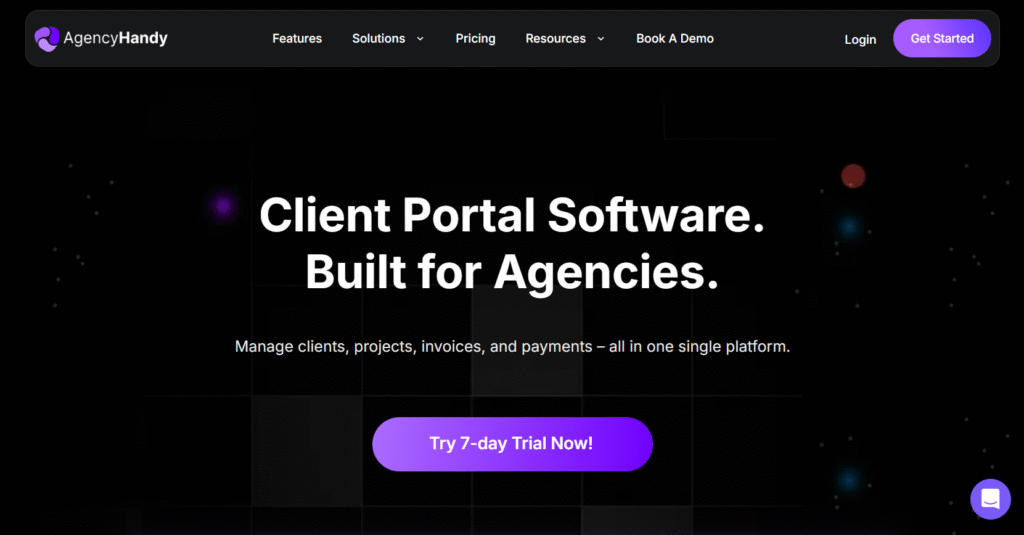
Agency Handy is the best alternative to Zuora for teams that need reliable subscription billing without developer dependence. You can set up recurring plans, track active subscriptions, and send invoices that automatically match each client’s billing cycle.
Next comes the service listing. You can build detailed service listings, recurring or one-time, with clear pricing and descriptions. It keeps your offerings structured while helping clients see exactly what they’re paying for.
The invoicing system is just as flexible. You can create branded templates, apply taxes or discounts, and trigger invoices automatically when projects renew or milestones close. Plus, built-in payment gateways let clients pay securely online, so you get paid faster
Everything works together in one space. From proposals and time tracking to white-labeled collaboration, Agency Handy connects every part of your client workflow.
Pros of Agency Handy
- Much faster implementation compared to Zuora’s months-long process
- Full white-label customization included in all plans (unlike Zuora’s tier-restricted branding)
- More flexible payment options, including Wise for international transactions
- Visual subscription management dashboards for easy monitoring
- All-in-one platform for CRM, subscriptions, and billing
Agency Handy Pricing
Agency Handy offers 3 flexible pricing plans:
What Users Say About Agency Handy
Rating on G2: 5 out of 5
“Handy is a fantastic client portal tool for agencies due to its user-friendly interface, making it easy for clients to access and navigate through the platform.” – Andrew J.
Rating on Trustpilot: 3.8 out of 5
“I am extremely satisfied with Agency Handy. It has streamlined our client management process and has become an essential tool for our business operations.” – Vikas Patil
Rating on Product Hunt: 5 out of 5
“A great tool for agency management. AgencyHandy solves all my management problems easily. A hassle-free tool you should add to your list.”- Shamima Nasrin
Is Agency Handy Better Than Zuora?
Agency Handy definitely outperforms Zuora in several key areas that matter to subscription businesses:
| Zuora Limitations | How Agency Handy Excels |
| Complex Implementation (3-6 months) | Rapid setup with guided onboarding (days to weeks) |
| Overwhelming Interface with Steep Learning Curve | Intuitive dashboard with logical workflow organization |
| Limited Service Cataloging Capabilities | Flexible multi-package subscription catalogs with trial options |
| Rigid Workflow Customization | Visual subscription management with adaptable processes |
| White-Labeling Only on Premium Tiers | Complete white-label customization on all plans |
| Limited Payment Gateway Options | Multiple payment methods including international options |
2. FastSpring
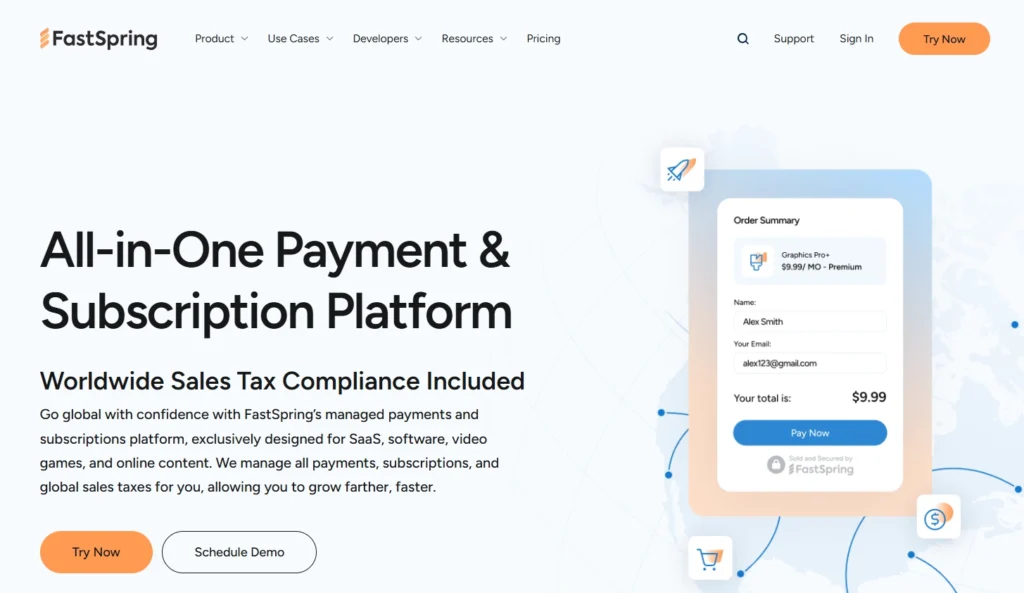
FastSpring stands out among subscription revenue platform alternatives to Zuora by handling the complexities of global tax compliance and transaction liability.
Unlike Zuora, which leaves businesses to navigate complex tax regulations on their own, FastSpring acts as a merchant of record, taking on the burden of tax collection, remittance, and compliance across multiple jurisdictions.
This comprehensive approach to global commerce makes FastSpring particularly valuable for businesses expanding internationally. It provides localized checkout experiences with multiple languages and currencies, boosting conversion rates and reducing friction for international customers.
While FastSpring may be more expensive than some alternatives and less flexible for certain business models, its ability to simplify global expansion and remove tax compliance headaches makes it a compelling choice for businesses with international ambitions.
Features of FastSpring
Let’s explore the key features that make FastSpring a strong Zuora competitor:
- Custom Subscription Models FastSpring lets you create most subscription types without code in just a few clicks. For complex needs, use their API and webhooks, making it accessible to businesses of all technical levels.
- Flexible Trial Options Control every aspect of trials – choose whether to collect payment info, set any trial length, and create various trial types. You decide if billing happens automatically after trials end.
- Versatile Subscription Management Set frequency and billing dates or let customers choose. Make subscriptions auto-renew or require manual approval, offer discounts, and add one-time purchases to initial bills.
- Digital Invoicing for B2B Manage B2B and B2C orders together with real-time custom quotes, expiration dates, and personalized notes. This unified approach simplifies serving both markets.
- Global Tax Compliance As a merchant of record, FastSpring handles all tax obligations across jurisdictions. This removes a significant burden from businesses selling internationally.
Pros of Using FastSpring
- Takes on tax liability and compliance responsibilities
- Simplifies global expansion with localized payment options
- Reduces churn with flexible payment recovery tools
- Handles complex international tax requirements
- Provides built-in fraud protection
Cons of Using FastSpring
- May be more expensive than other options
- Less flexible for certain business models
- Limited customization for some checkout elements
FastSpring Pricing
FastSpring offers custom pricing based on transaction volume and specific business needs. While they don’t publish specific rates, they typically charge a percentage of each transaction plus a small fixed fee.
What Users Say About FastSpring
Rating on TrustRadius: 9.0 out of 10 for likelihood to recommend
Users really appreciate FastSpring’s ability to handle global tax compliance and provide localized checkout experiences. The platform gets high marks for its merchant of record services that remove the burden of tax liability from businesses expanding internationally.
Some users note that while the platform excels at global commerce, it can be more expensive than alternatives that don’t offer the same level of compliance and localization support.
Is FastSpring Better Than Zuora?
FastSpring beats Zuora for global businesses by handling all tax compliance as a merchant of record – a huge burden Zuora leaves to you. Its all-in-one approach simplifies international operations and localized payments.
Companies needing simplified global commerce will prefer FastSpring, while those with complex subscription models might still consider Zuora.
3. Chargebee
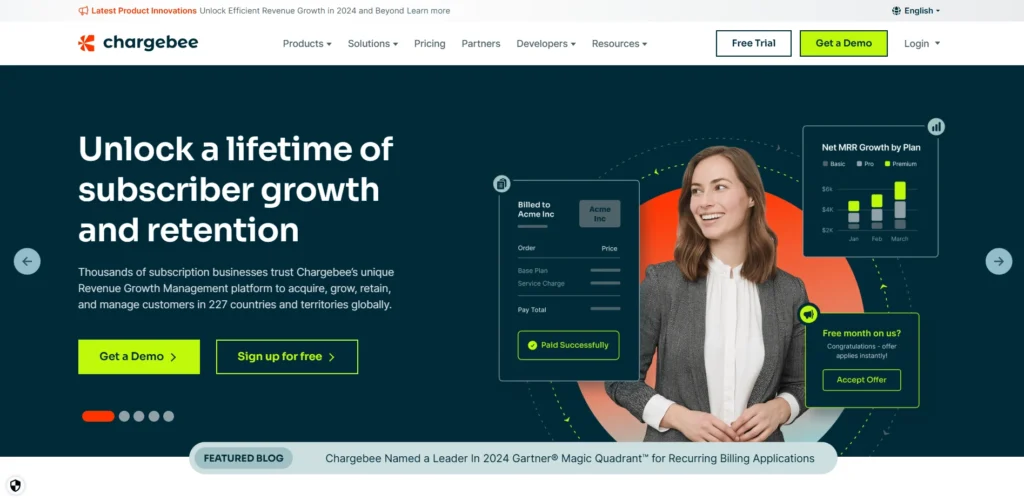
Chargebee is a user-friendly subscription billing alternative to Zuora known for its intuitive interface and transparent pricing structure.
Unlike Zuora’s complex implementation process, Chargebee offers a significantly faster setup that can be completed in days or weeks rather than months. This makes it an excellent choice for businesses that need to start billing customers quickly.
Chargebee excels at subscription management with flexible billing models, automated dunning management to reduce failed payments, and customizable checkout pages. Its user-friendly interface requires minimal training, allowing your team to become productive faster.
With strong documentation and responsive customer support, Chargebee addresses one of Zuora’s common pain points. However, it may lack some of the advanced features needed by enterprise users with very complex billing requirements.
Chargebee is a user-friendly subscription billing alternative to Zuora known for its intuitive interface and transparent pricing structure.
Unlike Zuora’s complex implementation process, Chargebee offers a significantly faster setup that can be completed in days or weeks rather than months. This makes it an excellent choice for businesses that need to start billing customers quickly.
Chargebee excels at subscription management with flexible billing models, automated dunning management to reduce failed payments, and customizable checkout pages. Its user-friendly interface requires minimal training, allowing your team to become productive faster.
With strong documentation and responsive customer support, Chargebee addresses one of Zuora’s common pain points. However, it may lack some of the advanced features needed by enterprise users with very complex billing requirements.
Features of Chargebee
Here are the key features that make Chargebee a strong Zuora alternative:
- Subscription Management: Manages the entire subscription lifecycle with intuitive controls. Customers can switch between tiers, while the system automates renewals and cancellations to reduce churn. Supports free/discounted trials without Zuora’s complexity.
- Customer Portals: Self-service portals for customers to manage subscriptions, update payment info, and download invoices. Reduces support needs while offering a user-friendly interface, unlike Zuora’s overwhelming customer experience.
- Payment Gateway Integration: Connects with multiple payment processors (Stripe, PayPal, Braintree) without integration headaches. Offers regional payment options through a straightforward system compared to Zuora’s complex ecosystem.
- Automated Dunning Management: Reduces failed payments using smart retry logic and customizable communication sequences. Maintains revenue without manual intervention while preserving customer relationships through intelligent recovery attempts.
- Customizable Checkout Pages: Create branded checkout experiences that match your website. Pages can be embedded or hosted separately, without requiring developer resources, unlike Zuora’s approach.
Pros of Using Chargebee
- Significantly faster setup compared to Zuora
- Transparent pricing with tiered plans
- Responsive and helpful customer support
- Excellent documentation and resources
- Regular feature updates based on user feedback
Cons of Using Chargebee
- May lack some advanced features needed by enterprise users
- Limited customization for complex billing scenarios
- Majority of advanced features are available only in Enterprise tiers
Chargebee Pricing
- Launch Plan: Starts at $249/month for up to $600K in revenue
- Rise Plan: Starts at $549/month for up to $1.2M in revenue
- Scale Plan: Starts at $949/month for up to $2.4M in revenue
- Enterprise Plan: Custom pricing for businesses with higher revenue
What Users Say About Chargebee
Rating on G2: 4.5 out of 5
“What I like best about Chargebee is its intuitive interface and comprehensive subscription management capabilities. The platform makes it easy to set up different pricing models, manage recurring billing, and track customer lifecycles all in one place. Their documentation is excellent, and the customer support team is always responsive and helpful.”
“The main drawback is that some of the more advanced customization options require technical knowledge or developer resources. Also, while the analytics are good, they could be more robust for deeper business insights.”
Is Chargebee Better Than Zuora?
Chargebee offers significant advantages over Zuora in terms of ease of use and implementation speed. While Zuora typically requires months to fully implement, Chargebee can be set up and running in weeks or even days to start billing customers much faster.
Chargebee also provides more transparent pricing than Zuora, making it easier for businesses to predict costs as they scale. Its user-friendly interface requires less training and technical expertise, reducing the overall cost of ownership compared to Zuora.
4. Orb
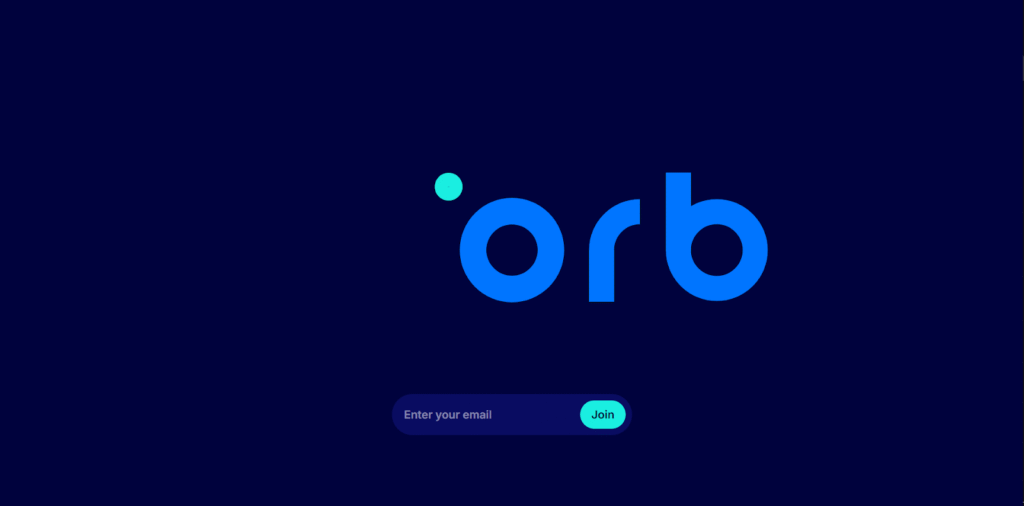
If Zuora seems complicated and hard to navigate, Orb is a simpler alternative. It’s built to make managing usage-based billing and subscription models easier.
You can create complex pricing models, track usage metrics, and generate detailed invoices without wasting time figuring out complicated features. It keeps things simple so you can focus on growing your subscription business.
Orb is really good at processing large amounts of usage data efficiently. Its platform is specifically built for usage-based billing, making it perfect for businesses with metered services or consumption-based pricing.
With built-in plan versioning for easy pricing updates, Orb helps you evolve your pricing strategy without disrupting existing customers or requiring complex migrations.
That said, Orb might be too much for businesses with simple subscription models, and its pricing isn’t publicly available, which could be an issue for budget-conscious organizations.
Features of Orb
Key features of Orb include:
- Usage-Based Billing: Orb excels at tracking and billing based on consumption metrics like API calls, storage usage, or user seats. The system ensures accurate billing for exactly what customers use, making it perfect for metered services.
- Superior Invoicing: The platform creates detailed invoices with usage graphs, timelines, and individual pricing insights.
- Plan Versioning: Orb lets you easily update pricing models without disrupting existing customers or requiring complex migrations.
- Direct SQL Editor: Users can access and query billing data directly with SQL for custom reporting and analysis.
- Real-Time Usage Processing: The system tracks and processes usage data in real-time, allowing for accurate billing and preventing revenue leakage from delayed or missed usage events.
Pros of Using Orb
- Great at processing large amounts of usage data
- Intuitive design makes billing management precise even for non-technical users
- Streamlined pricing adjustments without complex migrations
- Detailed invoicing provides transparency for customers
- Developer-friendly API for custom integrations
Cons of Using Orb
- May be overkill for businesses with simple subscription models
- Pricing not publicly available
- Less focus on client management features
Orb Pricing
Orb offers custom pricing based on business needs and scale. Contact Orb directly for a personalized quote.
What Users Say About Orb
While specific ratings from major review platforms aren’t widely available, customer testimonials highlight Orb’s strengths in handling complex usage-based billing scenarios. Users really appreciate its ability to process large volumes of usage data efficiently and provide clear, detailed invoices that help reduce billing questions.
Is Orb Better Than Zuora?
Orb outshines Zuora specifically for businesses with usage-based or metered billing models. While Zuora offers usage billing capabilities, Orb’s purpose-built platform provides more granular control and real-time processing that Zuora struggles to match.
Orb’s simplified pricing updates and version control make it easier to evolve pricing models without disrupting existing customers, a common pain point with Zuora.
For businesses whose revenue depends on accurately tracking and billing usage metrics, Orb provides a more specialized and efficient solution than Zuora’s broader but less focused approach.
5. Tridens Monetization
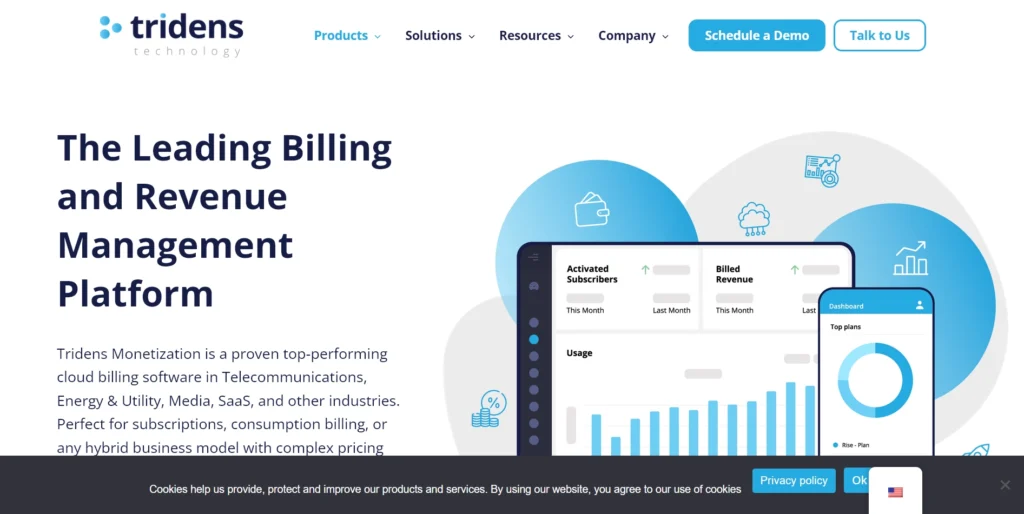
Tridens Monetization is a flexible recurring billing platform like Zuora that specializes in complex pricing models and high transaction volumes.
Unlike Zuora’s more rigid framework, Tridens offers exceptional flexibility for creating unique pricing structures and adapting to specific industry requirements without extensive customization. This makes it ideal for businesses with highly specialized billing needs.
Tridens excels at handling sophisticated B2B billing scenarios and high transaction volumes efficiently. It provides comprehensive revenue management tools and strong integration capabilities with payment gateways, ERPs, and CRMs.
While Tridens may have a steeper learning curve for new users and custom pricing that’s less predictable, its adaptability to unique business requirements makes it a compelling alternative for companies with complex billing needs.
Features of Tridens Monetization
Here are the key features that make Tridens Monetization a powerful Zuora alternative:
- Flexible Pricing Models: Implements innovative pricing models and handles millions of daily usage events. Supports tiered, volume-based, hybrid, and usage-based structures, giving more freedom than Zuora’s rigid approach for businesses with unique billing needs.
- Subscription Management: Automates end-to-end subscription processes including invoicing, complex charge calculations, payment reminders, and plan changes.
- Real-time Analytics: Provides a 360° view of subscription metrics through real-time reports. Offers clear visibility into costs and revenue balance, helping teams make faster decisions without waiting for monthly reports like with Zuora.
- Integration Capabilities: Features open APIs that quickly connect with existing infrastructure and business systems.
- Automated Payment Recovery: Automates payment recovery with intelligent retry sequences for failed transactions.
Pros of Using Tridens Monetization
- Excellent for businesses with intricate pricing structures
- Handles high transaction volumes efficiently
- Strong integration capabilities
- Comprehensive revenue management
- Highly adaptable to unique business requirements
Cons of Using Tridens Monetization
- Custom pricing may be less predictable
- Steeper learning curve for new users
- Less focus on client management features
Tridens Monetization Pricing
Tridens Monetization offers custom pricing based on specific business requirements and scale. Contact them directly for a personalized quote tailored to your needs.
What Users Say About Tridens Monetization
While specific ratings from major review platforms aren’t widely available, customer testimonials highlight Tridens’ flexibility in handling complex pricing models and its ability to adapt to unique business requirements. Users particularly value its capability to manage sophisticated B2B billing scenarios and high transaction volumes.
Is Tridens Monetization Better Than Zuora?
Tridens outperforms Zuora for businesses with specialized pricing needs. It offers greater flexibility for unique pricing structures and industry-specific requirements without complex customization.
With faster response times and quicker feature implementation than Zuora’s rigid system, Tridens delivers superior adaptability for companies whose billing needs don’t fit standard models.
6. Recurly

Recurly stands out as a subscription billing platform built specifically for developers who need to handle complex subscription scenarios. Unlike Zuora’s broader approach, Recurly focuses exclusively on optimizing recurring billing management.
This developer-centric platform makes it easier to customize your subscription system to match your exact business requirements. It handles different billing situations effectively, including changing prices, offering discounts, and managing various subscription types.
Recurly excels at keeping customers subscribed through robust dunning management features. Its specialized design for recurring payments provides a more refined experience than Zuora’s sometimes overwhelming approach.
Features of Recurly
- Focus on Recurring Billing: Recurly specializes in subscription and recurring billing management with features designed specifically for handling the unique requirements of recurring payments.
- Robust Dunning Management: The platform includes comprehensive dunning tools that help reduce involuntary churn through automatic payment retries and customizable communication sequences, recovering failed payments more effectively than Zuora.
- Developer-Friendly Design: Recurly’s developer-centric approach offers extensive customization options, making it easier to tailor the platform to your specific business needs when flexibility is essential.
Pros of Using Recurly
- Much faster implementation compared to Zuora (weeks versus 3+ months)
- Large set of reporting capabilities and data exports
- Excellent scalability (works well with “10 or 10,000 active customers”)
- Flexible customization options for automated email templates
- Strong uptime performance
Cons of Using Recurly
- Multiple subscriptions on a single account can be clunky to manage
- Short auto time-out due to inactivity (constantly forces users to log back in)
- Limited dunning churn reporting capabilities
Recurly Pricing
- Starter Plan: $249 per month
- Professional Plan: Custom pricing based on business needs
- Elite Plan: Custom pricing based on business needs
- Note: Previously offered a Core plan at $99 per month (no longer available)
What Users Say About Recurly
Rating on Capterra: 4.6 out of 5
“I value the support from the Recurly team, they’re incredibly helpful and I’d be lost without them. I’m fond of its design and user-friendly interface.”
“Recurly’s reporting & analytics gave our team more insight and clarity into our business than we’ve ever had previously, allowing us to make timely pivots and easily view the results.”
Is Recurly Better Than Zuora?
Recurly outperforms Zuora for businesses that prioritize developer flexibility and specialized subscription management. Its focused approach to recurring billing provides more refined features for handling subscription complexities. For companies with technical resources and unique billing requirements, Recurly offers a more adaptable solution than Zuora’s broader but less specialized approach.
7. Maxio
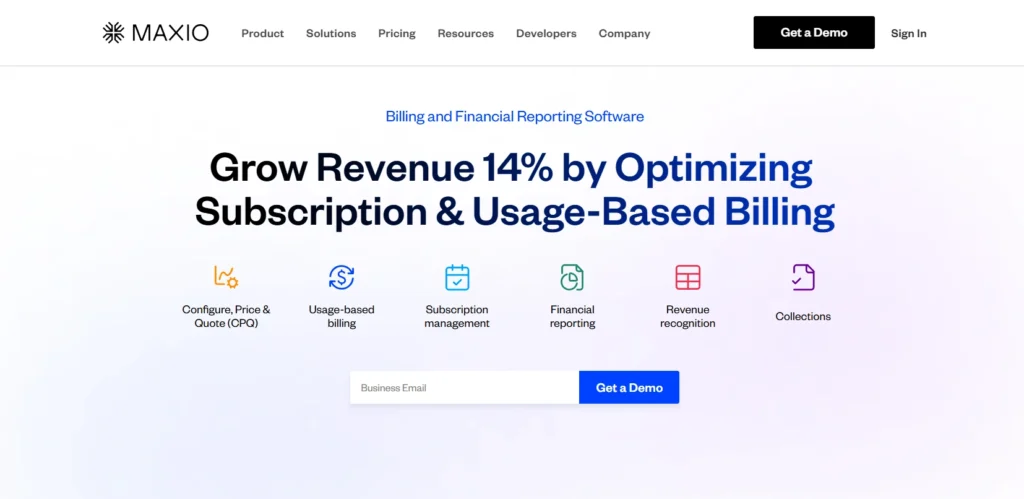
Maxio is designed specifically for B2B SaaS businesses with complex billing needs and rapid growth trajectories. It offers a comprehensive billing and financial platform that emphasizes adaptable pricing models and effective subscription management.
While Zuora often struggles with limitations for high-growth companies, Maxio excels at accommodating expanding businesses with complex billing processes. Its platform automates billing tasks and provides powerful financial reporting tools that support GAAP compliance.
Maxio can handle high-complexity billing scenarios, including revenue recognition and multi-currency support. This makes it ideal for rapidly scaling businesses with intricate billing requirements.
Features of Maxio
- Built for High Growth: Maxio effectively manages large subscriber volumes and complex billing processes, making it ideal for rapidly expanding businesses where Zuora imposes too many limitations.
- Customizable Workflows: Unlike Zuora’s rigid framework, Maxio offers greater customization possibilities, allowing businesses to adapt the platform precisely to their unique needs and workflows.
- Advanced Billing Capabilities: The platform excels at handling complex billing scenarios, offering features like revenue recognition and multi-currency support that give it an edge over Zuora for businesses with intricate billing requirements.
- Tailored for B2B SaaS: Designed specifically for SaaS companies with simple usage-based pricing models, Maxio can handle tiered, stair-step, events-based, and metered billing efficiently.
Pros of Using Maxio
- Payment management made effortless through intuitive design
- Customer billing portal functionality that allows clients to update information and access invoices
- Effective KPI tracking for important SaaS metrics
- Good API connectors for automation between different systems like Salesforce and QuickBooks
- Revenue tracking that is “extremely accurate and helpful”
Cons of Using Maxio
- Implementation can be “a heavy lift depending on the systems you are coming from”
- Revenue recognition functionality for ASC 606 compliance isn’t as robust as some users would like
- Limited reporting capabilities for mid-month or specific day reporting
- Integration issues, particularly with Stripe where “sometimes stripe debits a different amount than in Maxio”
Maxio Pricing
- Build Plan: Free for 30 days (sandbox environment)
- Grow Plan: $599/month (supports up to $100,000 in monthly billing volume)
- Scale Plan: Custom pricing with volume-based discounts for higher billing volumes
What Users Say About Maxio
“I have been a Maxio user for over 7 years in some capacity. I love the ability for customers to have a billing portal to update their information and grab invoices as needed, as well as the KPI tracking for important SaaS Metrics.”
“Some of the best parts of using Maxio is its interface. Everything is laid out well and sending invoices and processing transactions is made easy because of it. Its revenue tracking is one of the best features and is extremely accurate and helpful.”
Is Maxio Better Than Zuora?
Maxio outperforms Zuora for rapidly growing B2B SaaS companies that need flexibility and scalability. Its tailored workflow options and stronger billing capabilities make it better suited for businesses with complex needs that Zuora’s rigid system can’t accommodate. While it requires some technical resources to fully leverage, Maxio provides superior adaptability for companies experiencing high growth.
Why Consider Alternatives to Zuora?
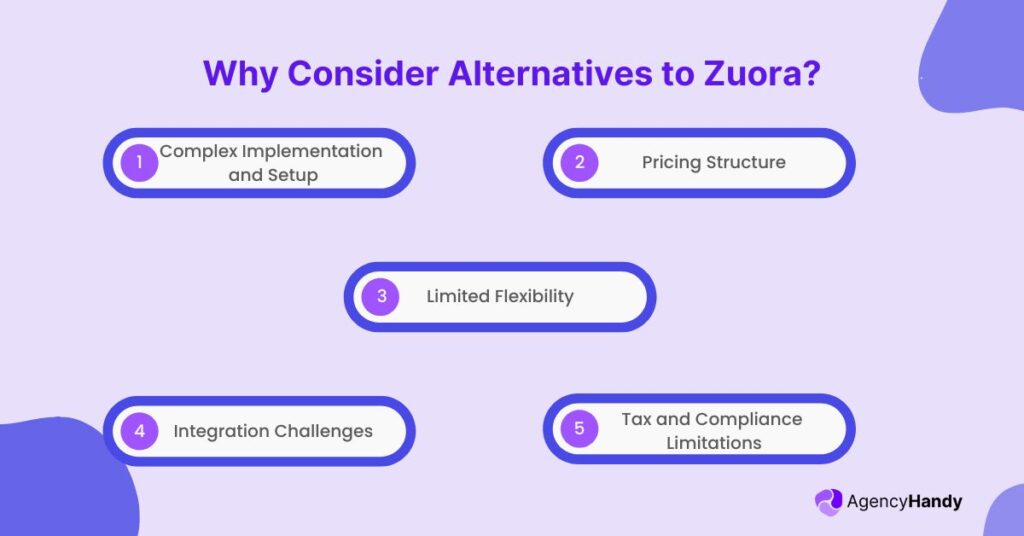
Before get into the alternatives, let’s understand why you might need a Zuora replacement:
Complex Implementation and Setup
Zuora has earned a reputation for its cumbersome setup process that spans multiple stakeholders and can take months to complete.
The learning curve is steep, and configuring workflows can be complicated, slowing down productivity and requiring extensive training.
Pricing Structure
Zuora’s pricing structure can be complex and unpredictable. Many of its best features are only available on more expensive plans, making it less cost-effective for smaller businesses or those with tight budgets. This lack of transparency can lead to unexpected costs as your business grows.
Limited Flexibility
While Zuora offers detailed workflows, they’re not always flexible enough to adapt to different business models.
Making quick changes or adjusting the system to fit evolving needs can be frustrating, especially for businesses with unique requirements or those experimenting with different pricing strategies.
Integration Challenges
Zuora doesn’t offer native integrations for all the tools your business relies on. It often depends on third-party integrations for features like file sharing and detailed analytics, which can make workflows more complicated and increase overall costs.
Tax and Compliance Limitations
One of Zuora’s main shortcomings is that it doesn’t handle sales tax or transaction liability for you. This leaves businesses on their own to navigate complex tax regulations across different countries and states, creating significant compliance risks.
How to Choose the Right Zuora Alternative
When selecting a subscription automation tool to replace Zuora, consider these key factors:
Business Size and Complexity
Your business size matters when choosing a Zuora alternative. Startups and small businesses should look to Agency Handy or Chargebee for user-friendly interfaces and affordable pricing.
Mid-market companies will find FastSpring or Orb offer the right balance of features and scalability.
Enterprise organizations need Tridens Monetization’s robust customization capabilities and comprehensive features to handle complex operations across multiple departments.
Pricing Model Requirements
Let your pricing approach guide your platform choice. For straightforward subscriptions, Agency Handy or Chargebee provide efficient management without complications.
Companies using usage-based billing should consider Orb, which specializes in consumption metrics tracking.
For complex hybrid pricing combining multiple approaches, Tridens Monetization handles intricate structures that Zuora’s rigid framework can’t accommodate.
Technical Resources
Your team’s technical capabilities should influence your decision. Organizations with limited IT staff should choose Agency Handy and Chargebee for their intuitive interfaces requiring minimal technical expertise.
Teams with strong development resources will benefit from Orb and Tridens, which offer powerful APIs and extensive customization options that reward technical investment with specialized functionality.
Global Operations
International businesses have specific needs. FastSpring excels by handling complex tax compliance as a merchant of record. While all alternatives support multiple currencies, Agency Handy and FastSpring excel internationally.
They offer localized payment methods and regional invoicing, making global expansion simpler without Zuora’s compliance issues.
Conclusion
For businesses sick of wrestling with Zuora’s complicated mess, Agency Handy feels like finally getting a tool that just works.
We’ve gone through all the alternatives, and honestly, switching to Agency Handy isn’t just swapping one system for another – it’s actually fixing how you handle customers and make money month after month.
No more waiting forever to implement things. No more calling in the tech team for every little change. Agency Handy gets you up and running in days, not months, and regular people on your team can actually use it without a training course.
FAQs About Zuora Alternatives
What is the best Zuora alternative for small businesses?
Agency Handy wins for small businesses with its intuitive interface, transparent pricing, and all-in-one approach combining subscription management, client portals, and invoicing – implementable without technical expertise.
How do Zuora alternatives compare in terms of pricing?
Most alternatives offer clearer pricing than Zuora. Agency Handy starts at just $49/month with core features included, while others like Chargebee start higher. Agency Handy provides the most predictable costs as you scale.
Can I easily migrate from Zuora to an alternative platform?
Yes! Agency Handy offers the smoothest transition with comprehensive migration support and implementation specialists who map your existing subscription data to the new system with minimal disruption.
Which Zuora alternative has the best reporting capabilities?
Agency Handy features the most user-friendly and comprehensive reporting with intuitive dashboards for subscription metrics, revenue recognition, and customer behavior – accessible to non-technical users without requiring SQL or developer help.








